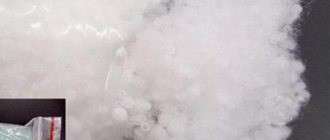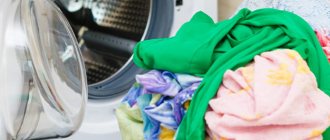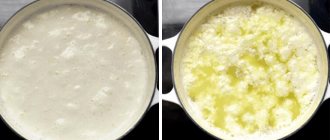In fact, new things are definitely worth washing, and the point here is not only that they have already been tried on before you.
Chemicals can lurk in clothes even after washing.
Unfortunately, washing will not remove all chemicals from clothing. For example, the antimicrobial substance triclosan is sometimes added to fabrics, including clothing. Research has shown that triclosan may interfere with hormone regulation and interfere with fetal development.
Animal studies have also raised concerns about its ability to affect fertility, and bacteria exposed to triclosan may become resistant to antibiotics. There have even been suggestions of an increased risk of cancer.
Meanwhile, fade-resistant clothing is a common source of perfluorinated compounds (PFCs), which are toxic to humans and the environment. PFCs are most often heard of in connection with the non-stick properties of cookware, but they are also often found in fabrics .
Unless you buy organic clothing, the clothes sold in stores are made from genetically modified cotton that is heavily treated with pesticides and other chemicals during the manufacturing process.
The Organic Consumers Association (OCA) explains:
“The chemicals used in cotton production extend beyond cultivation. To make harvesting easier, herbicides are used, which cause the plants to shed their leaves - then the boxes are much easier to pick. The process of making textiles from plants uses a variety of chemicals - for bleaching, sizing, dyeing, straightening, anti-shrinkage, stain and odor resistance, fire retardant and antistatic properties, moth resistance, and to reduce wrinkles. Some of these chemicals are applied through a heat treatment that bonds them to the cotton fibers. During the entire process, the fabric is washed several times, but the remaining conditioners and powders are not completely washed out of the final product. Chemicals often used for finishing fabrics include formaldehyde, caustic soda, sulfuric acid, bromine, urea resins, sulfonamides and halogens. Imported clothing is often impregnated with persistent disinfectants (very identifiable by smell) that are very difficult to remove. These and other chemical residues are dangerous for people with multiple chemical sensitivities. In addition, people have developed allergic reactions, such as hives, to formaldehyde due to skin contact with formaldehyde-containing solutions used in ironing clothes.
How to wash new clothes for newborns correctly
Washing newly purchased clothes for newborn children is a mandatory process. It is not known who touched them and what path they traveled before getting to the counter.
Here are some tips on how to wash new clothes for newborns:
- You need to wash clothes for babies with a special powder for babies. You can also use fragrance-free baby soap. If this is not possible, you can use laundry (not white) soap. But after such a procedure, you need to rinse the item well to remove all alkali and odor.
- Do not use any conditioners. Even a product with the most harmless composition can provoke a severe cough in a baby.
- All washed items must be thoroughly ironed and steamed.
You can wash new clothes for babies either manually or in an automatic machine. Be sure to check the manufacturer's recommendations on the label; they may differ from those listed, depending on the material.
You can and should wash new things. Any item of clothing, be it a blouse or a set of underwear, goes through many stages of processing and transportation. If you wear such clothes without first washing, you run the risk of irritation.
There is no need to worry about fading of a new item after the first wash - follow all the rules and it will not lose its original appearance. In any case, it is better to be safe, especially when it comes to clothes for newborns.
Conventionally grown genetically modified cotton is 'the world's dirtiest crop'
You may be surprised, but cotton is considered the dirtiest crop in the world due to the heavy use of hazardous herbicides and insecticides in the cotton industry, including some of the most dangerous insecticides available on the market. According to the Organic Trade Association:
“Cotton is considered the dirtiest crop in the world due to the extensive use of insecticides and the most dangerous pesticides for human and animal health. Cotton covers 2.5% of the world's arable land, but uses 16% of the world's insecticides - more than any other single crop. Aldicarb, parathion and methamidophos , the three most hazardous insecticides to human health identified by the World Health Organization, are among the ten most commonly used in cotton production. Another six commonly used ones are classified as moderate to very dangerous. Aldicarb is the second best-selling insecticide for cotton and is the most poisonous to humans; just a drop of this substance can kill a person if absorbed through the skin; however, it continues to be used in 25 countries and in the United States, where 16 states have reported its presence in groundwater.”
As you can imagine, this is dangerous on several levels - for the farmers handling these chemicals, for the people living nearby, for the consumers buying the cotton, and for virtually everyone who will end up affected by this widespread environmental pollution.
This is the reason why I highly recommend choosing organic cotton clothing if possible - it will not be genetically modified and will not suffer from the terrible effects of toxins.
Why new clothes and linen need to be washed - the main reasons
New items must be washed. Many people don’t even think about how this or that item was made, how many stages of processing it went through before getting to the counter, what harmful substances it was saturated with, how many people tried it on, and how many pathogenic bacteria remained after them.
Pathogenic microorganisms and bacteria
Most likely, the wardrobe item you have chosen has been tried on by several dozen people before you. At best, there are particles of someone else's sweat left on him in the armpit and buttock area. At worst - fungi and microbes.
Particular disgust should be shown when it comes to underwear or swimwear.
Whitening
Another reason why washing new clothes is necessary is bleach. If you bought a snow-white dress, you should know how far it went before acquiring this shade, because initially any fabric has a brownish color.
To achieve a snow-white shade, the material is treated with peroxide and chlorine. The material is then dried and blown, but particles of these compounds still remain on it.
You should not refuse to wash new wardrobe items, otherwise there is a risk of developing an allergic reaction.
Dyes
Since initially any fabric has a brown tint, it is obviously treated with dyes to give it color. The denser the material, the more dyes it contains. Many dyes contain carcinogens - substances that increase the likelihood of malignant tumors.
It is necessary to wash new linen and clothes, if only to prevent allergies to dyes.
Preliminary processing
Before it falls into the hands of the buyer, the material goes through several stages of processing. In almost all cases it is treated with formaldehyde. This organic compound prevents bacterial growth and mold development during transportation. However, this compound can provoke an allergic reaction.
In addition, all materials are treated with water-repellent impregnations to make the item look presentable. Water-repellent solutions also contain a lot of substances harmful to the body, so washing new linen and clothes is necessary.
Phthalates
Phthalates are substances that are used as plasticizers. Phthalates are used to treat various patterns and patterns on clothing to give them softness and elasticity.
If such a compound gets ingested, it has a negative effect on the hormonal system, liver and lungs.
New soft toys should also be washed after purchase if they are intended for small children.
Safe clothing: basic tips
Looking for items made from organic cotton is a great start to finding clothes that are safe and non-toxic (for you and the environment). You can look for the OEKO-TEX Standard 100 label - this indicates that the clothing has been tested by an independent laboratory that has documented that the clothing does not contain harmful levels of more than 100 substances, including:
- Azo dyes
- Phthalates
- Heavy metals
- Pesticides
- Allergenic dyes
Finally, many experts actually recommend washing new clothes when you bring them home from the store, maybe even twice. If the item is not machine washable, run it through a hot dryer cycle before wearing it.
When you try on new clothes in a store, don’t take off all your clothes (at least your underwear, and when you get home, wash that too). It's also a good idea to wash your hands after shopping, as you may have touched items that may have had chemicals or other contaminants on them. published
PS And remember, just by changing your consumption, we are changing the world together! © econet
Rules for washing new things after purchase - how to do it so as not to spoil the thing
Some people are afraid to wash things because after washing they can shrink, become faded and lose their original appearance.
To prevent this from happening, you need to wash your new clothes properly. The first and most important rule is to study the tag on the clothing, where the manufacturer indicates all the necessary information.
Recommendations will vary depending on the material:
- Wool, cashmere and silk cannot be machine washed - only by hand, only in cold water and only separately.
- Cotton can be washed either in an automatic machine or by hand, at a water temperature of 30-40 degrees.
- Synthetic materials can be machine washed. If the item does not contain elastic materials, you can safely use a machine spin.
In addition to the material, the color of the clothing plays a big role. The washing rules are the same for colored items, but different for black and white items.
Before washing new items, check the washing instructions on the label or tag.
How to wash black clothes
Often after the first wash, black items stop being black and become dark gray.
- To prevent this from happening, the temperature should not exceed 30 degrees.
- It is also important not to overdo it with washing powder. It should be slightly less than when washing colored laundry.
- It’s even better to use liquid gels for black clothes, since most washing powders contain bleaches, peroxides and chlorine.
How to wash colored clothes
Colored clothes of similar shades can be washed mixed. For example, a red sweater, a yellow dress and an orange turtleneck, or a green paita and blue pants can be washed together.
But, first, you should make sure that the thing will not be painted too much. To do this, dip a small part of the colored item in hot water for a minute, then run the wet part over the white material. If a pronounced tint remains on the white material, then it is better to wash the item separately and in cold water for the first time.
You can mix white things with colored ones only if the colored ones have a pastel tint. Otherwise, the white will either be completely colored or will have colored spots.
Washing bed linen
Many housewives have doubts when they are faced with the question of whether they need to wash new bed linen. However, there is no need to doubt it, since the linen is also impregnated with harmful chemicals. Moreover, the packaging could have been damaged during transportation, and if the material is natural, then no one can guarantee that the kit will be free from insects and ticks.
Here are some guidelines when washing a new bedding set:
- Wash bedding as a whole set, without mixing it with other items.
- It must be washed by hand at a temperature not exceeding 40 degrees.
- Instead of regular powder, use liquid gel, and then rinse your laundry in a special conditioner.
- When washing, it is not recommended to use bleaching powders, stain removers or color maintenance products.
- You cannot twist the laundry; you need to wring it out with your hands without much effort.
General recommendations
- The machine cannot be loaded end to end, but you should not leave a lot of free space. When the drum is completely clogged, the wash becomes much tougher, and as a result, the color of the items becomes more faded.
- Try to remove items from the machine immediately after washing. If you leave them in the drum for several hours, they may fade. We have already talked about how to get rid of faded stains on things, and how to avoid this in the future.
- Avoid machine drying. It is advisable to dry things in the open air, avoiding artificial heat sources.
- Use special powders and gels. It is important not to overdo it with their quantity. To get rid of stubborn dirt, use white vinegar. It also helps soften the material.
- To prevent new clothes from becoming faded after the first wash, turn them inside out. It is very important to follow this rule when washing bed linen.
- Before washing new bedding or any item of clothing, soak it in cold water and table salt for 10 minutes.
What happens if you don't wash clothes from the store?
It is far from certain that wearing unwashed clothes will have bad consequences. But there is always a risk that:
- skin irritation (redness, itching and rash - from microparticles of chemicals and lumps of paint stuck between the threads);
- allergies (if a person has intolerance to any of the substances);
- skin and sexually transmitted diseases, less often - colds and flu (if the person trying on sweated or sneezed);
- increased risk of developing various chronic diseases.
Rather than risk your health, it is better to thoroughly wash the purchased clothes. One treatment according to the rules is enough to completely protect yourself from trouble.
CYCLE ONE - WHITENING
Initially, all natural fabrics (threads) are dirty brown. They are soaked in bleach, hydrogen peroxide, acids or other bleaches to strip them of their natural color. Then it is dried and blown. What remains on the fabric? That's right, tiny dried particles of the solution in which it was bleached. And also the pigment residues that reacted with the bleach.
If you put this freshly made item on yourself and you have sensitive skin, you may get irritated. From mild urticaria to severe contact dermatitis. Stop, you say. I don't wear white. I wear colored things! Fine.
CYCLE TWO - DYING THE FABRIC WITH A CONTINUOUS BACKGROUND OR APPLYING A PRINTED PATTERN
The procedure is the same.
Wet dye (aniline azo dyes) is applied to the fabric and then dried. Blow off what has dried on the surface of the fabric. But the more textured and thick the fabric, the more microparticles of dried paint remain on it. In their pure form, most aniline dyes are carcinogenic. Clothes may not be dyed because the grains of paint are baked and do not dissolve in water. But they end up on your body with your sweat. I generally only wear undyed and unbleached items! Fine.
Do new shoes need to be cleaned?
Shoes are tried on many times, and from close contact with the feet, their insides become soaked with sweat. Also, those trying it on may have foot fungus. These are good reasons to thoroughly treat your shoes after purchase:
- wipe with a soapy sponge and dry (it’s better to do it naturally, but if you’re pressed for time, take a hairdryer);
- if the high boot makes it inconvenient to clean by hand, use a steam generator;
- After drying, put a bag of odor-absorbing balls inside.
The outer side of the shoe should also be treated, but for other reasons - to protect it from moisture and deformation. Shoe stores sell products for leather, suede and fabric shoes. These impregnations are applied to shoes and covered with cream for additional protection.
Garment factory - this item was sewn and ironed
After a long factory or manual process of forming a canvas from primary raw materials, the material ends up in the hands of a designer or factory. The fabric must be received and stored in a warehouse, prepared for production, patterns made using a stencil, cuts of the required size formed, sewn, and then ironed and packaged. How many hardworking hands were involved in this process? If they were cars, how clean were they?
Garment factory in China
Parasites in a new wardrobe
Doctors pay attention to the fact that along with new things we can bring parasites into the house. It is rare, but it happens that there are parasites - lice - in foreign wardrobes. Arthropods do not live on the skin, but hide in the folds of fabrics and seams to drink our blood at a convenient time.
Getting rid of lice is not easy; moreover, parasites in large numbers lead to the disease “pediculosis”. It is better to wash clothes of dubious quality and origin using an antiparasitic liquid. In some cases, parasites cause typhoid fever.
But shopaholics and those simply buying new clothes should not panic ahead of time. Try not to try on things on your naked body, especially underwear.
Never try on shoes barefoot, wash your hands after visiting stores. New clothes not only for children, but also for adults should be washed and ironed with a hot iron.
Clothes soaked in chemicals
Dermatologists warn: not only microbes on things can cause dangerous diseases. New clothes, as well as those that are purchased as used ones, are not always ready for purchase.
Such items must be washed before wearing for the first time. This is due to the possibility of the presence of chemicals that give the textiles a fresh look. We'll talk about them later. Chemicals are preserved when things are transported. One of the most dangerous substances found on clothing is formaldehyde resin.
It prevents the formation of mold, protects the fabric from moisture, so that the material is easily compressed and does not wrinkle. Clothes that are excessively saturated with formaldehyde can cause not only itching and redness of the skin, but also eczema. Allergic reactions are caused by dyes.
Dyes
It is rare that a tailor or tailoring company for mass consumption uses authentic colored natural fabrics without a single dye. Of course, even if they are natural, they are more often available. Have you ever noticed that bright blue jeans leave a mark on a white tank top? It is rare, but an item that has never been washed can (unwittingly) stain leather or lighter colored items. Here you need to be more careful.
Natural dyes
Fabric production, transportation and sales
First, it was necessary to produce those materials that were involved in the manufacturing process of the final product. The main fabric and, possibly, the lining were made at the factory by hand or on special large machines. How clean was it? How many people were involved in the transportation? How were the fabrics treated before going on sale? And this is just the first step.
Textile store, Chicago











